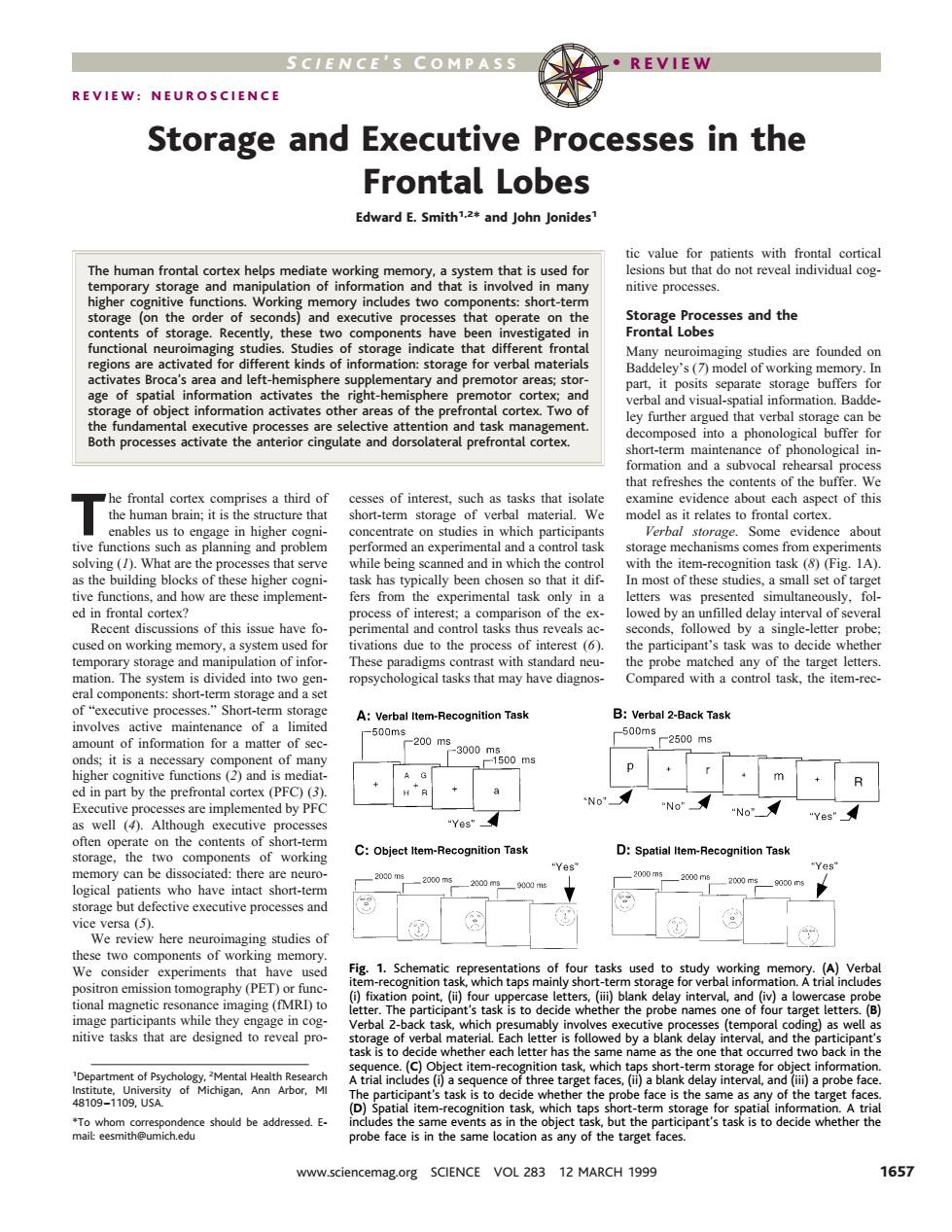正在加载图片...

scIENCE'S COMPASS REVIEW:NEUROSCIENCE Storage and Executive Processes in the Frontal Lobes Edward E.Smith1.2.and John Jonides frontal c ps me rag nitive processes. age (on the o of utive pro the tional neu dies o fstorageindicatethatdiferentfrontal studies are founded on ctivatesBr reaand eft-hemisphere sup as:stor ers from y in a the tio.The prShort-ie B:Y 2-Back Tas -500m 2500ms many -200m-300s0m A G p ed in part by the prefrontal m+R "No No "Yes y can be d 0—2000m9000 vi he Fig. 1.Sche ntations of four pa() nitive tasks that are designed to reveal pro ed by a ct item-r 5K. as any of the should be addressed E. es the n as any or the www.sciencemag.org SCIENCE VOL 283 12 MARCH 1999 1657REVIEW: NEUROSCIENCE Storage and Executive Processes in the Frontal Lobes Edward E. Smith1,2* and John Jonides1 The human frontal cortex helps mediate working memory, a system that is used for temporary storage and manipulation of information and that is involved in many higher cognitive functions. Working memory includes two components: short-term storage (on the order of seconds) and executive processes that operate on the contents of storage. Recently, these two components have been investigated in functional neuroimaging studies. Studies of storage indicate that different frontal regions are activated for different kinds of information: storage for verbal materials activates Broca’s area and left-hemisphere supplementary and premotor areas; storage of spatial information activates the right-hemisphere premotor cortex; and storage of object information activates other areas of the prefrontal cortex. Two of the fundamental executive processes are selective attention and task management. Both processes activate the anterior cingulate and dorsolateral prefrontal cortex. The frontal cortex comprises a third of the human brain; it is the structure that enables us to engage in higher cognitive functions such as planning and problem solving (1). What are the processes that serve as the building blocks of these higher cognitive functions, and how are these implemented in frontal cortex? Recent discussions of this issue have focused on working memory, a system used for temporary storage and manipulation of information. The system is divided into two general components: short-term storage and a set of “executive processes.” Short-term storage involves active maintenance of a limited amount of information for a matter of seconds; it is a necessary component of many higher cognitive functions (2) and is mediated in part by the prefrontal cortex (PFC) (3). Executive processes are implemented by PFC as well (4). Although executive processes often operate on the contents of short-term storage, the two components of working memory can be dissociated: there are neurological patients who have intact short-term storage but defective executive processes and vice versa (5). We review here neuroimaging studies of these two components of working memory. We consider experiments that have used positron emission tomography (PET) or functional magnetic resonance imaging (fMRI) to image participants while they engage in cognitive tasks that are designed to reveal processes of interest, such as tasks that isolate short-term storage of verbal material. We concentrate on studies in which participants performed an experimental and a control task while being scanned and in which the control task has typically been chosen so that it differs from the experimental task only in a process of interest; a comparison of the experimental and control tasks thus reveals activations due to the process of interest (6). These paradigms contrast with standard neuropsychological tasks that may have diagnostic value for patients with frontal cortical lesions but that do not reveal individual cognitive processes. Storage Processes and the Frontal Lobes Many neuroimaging studies are founded on Baddeley’s (7) model of working memory. In part, it posits separate storage buffers for verbal and visual-spatial information. Baddeley further argued that verbal storage can be decomposed into a phonological buffer for short-term maintenance of phonological information and a subvocal rehearsal process that refreshes the contents of the buffer. We examine evidence about each aspect of this model as it relates to frontal cortex. Verbal storage. Some evidence about storage mechanisms comes from experiments with the item-recognition task (8) (Fig. 1A). In most of these studies, a small set of target letters was presented simultaneously, followed by an unfilled delay interval of several seconds, followed by a single-letter probe; the participant’s task was to decide whether the probe matched any of the target letters. Compared with a control task, the item-rec- 1 Department of Psychology, 2 Mental Health Research Institute, University of Michigan, Ann Arbor, MI 48109 –1109, USA. *To whom correspondence should be addressed. Email: eesmith@umich.edu Fig. 1. Schematic representations of four tasks used to study working memory. (A) Verbal item-recognition task, which taps mainly short-term storage for verbal information. A trial includes (i) fixation point, (ii) four uppercase letters, (iii) blank delay interval, and (iv) a lowercase probe letter. The participant’s task is to decide whether the probe names one of four target letters. (B) Verbal 2-back task, which presumably involves executive processes (temporal coding) as well as storage of verbal material. Each letter is followed by a blank delay interval, and the participant’s task is to decide whether each letter has the same name as the one that occurred two back in the sequence. (C) Object item-recognition task, which taps short-term storage for object information. A trial includes (i) a sequence of three target faces, (ii) a blank delay interval, and (iii) a probe face. The participant’s task is to decide whether the probe face is the same as any of the target faces. (D) Spatial item-recognition task, which taps short-term storage for spatial information. A trial includes the same events as in the object task, but the participant’s task is to decide whether the probe face is in the same location as any of the target faces. S CIENCE ’ S C OMPASS ● REVIEW www.sciencemag.org SCIENCE VOL 283 12 MARCH 1999 1657